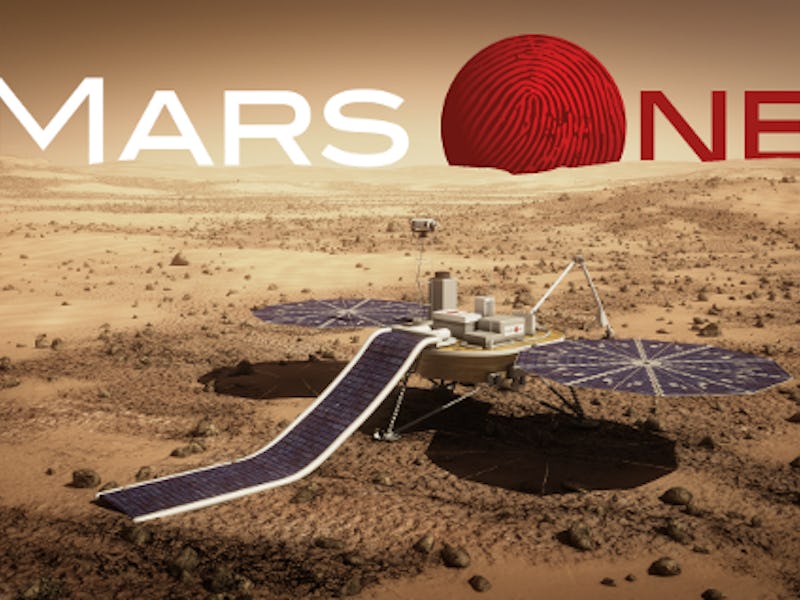On Wednesday, Mars One (which is apparently still a thing) announced its timeline for sending humans to the Red Planet would be delayed by five years. The company now says it plans on sending the first crew to Mars in 2031 — five years after the original 2026 projection. The reason? Unsurprisingly, its lack of funding.
Mars One CEO Bas Lansdorp issued a statement explaining that the venture didn’t have the necessary funding in order to undertake such a mission. In an effort to give the company enough time to raise sufficient funds, the timeline was pushed back.
“Mars One can only implement the mission to Mars if we can afford it — and we need investments to get going,” explained CEO Bas Lansdorp in a statement. “Being listed on a stock exchange will make fundraising more straightforward.”
In November, Mars One announced it was going public at the Frankfurt Stock Exchange, where a takeover agreement between the venture and InFinn Innovative Finance AG was confirmed. This will allow Mars One to raise funds through the exchange rather than relying on private donations.
“Mars One is very pleased to have been acquired by InFin. This step provides the opportunity to raise capital through the listing on the Frankfurt Stock Exchange,” Lansdorp said at the time. “This listing also supports our aim to attract international support to establish a permanent human settlement on Mars: our global followers will have the opportunity to be part of this adventure and to literally own a piece of this historic venture.”
A view of the proposed Mars One outpost on the red planet.
Now that Mars One shares are trading on the Franklin Stock Exchange, the company has hopes of raising $10 million in their first round of funding. This amount ensures the mission will progress. If successful, the funding Mars One raises will be used for a myriad of tasks, including: awarding new supply contracts, organizing the next round of astronaut selections, crew training, and hiring a team of experience individuals who will work towards getting Mars One off the ground. The company also expects to hire a specialized media team that will engage users worldwide through photo and video campaigns.
The Dutch-based venture, aims to establish a permanent human outpost on Mars by sending astronauts (four at a time) to the red planet. Sounds like SpaceX and NASA and pretty much every other space agency, right?
Except, there’s one big difference — the Mars One crew will have a one-way ticket. Meaning once they leave Earth, they won’t be coming back. So, if you’re like Eric Cartman in recent episodes of South Park and 2016 has you down, don’t go packing your bags for Mars just yet. The project may never get off the ground, much less make it to the Red Planet.
Mars One has been deemed sketchy since the start, as it planned on sending people to an uninhabited world on basically a shoestring budget — $6 billion is peanuts when talking about Mars. To give some perspective, NASA’s Curiosity rover came with an estimated $2.5 billion price tag. Nearly all of technologies needed to safely land people on Mars and subsequently survive have not yet been invented or are in the very early stages of development.
The Mars One rover.
Initially, Mars One planned on launching an orbiter to Mars this year, followed by a rover in 2018. It would be the rover’s duty to find a proper selection site for the eventual human missions. Next, the company planned on launching all the necessary hardware and supplies before launching the first crew of four in 2022. After that, a new crew of four would continuously launch every two years, for an undetermined amount of time.
While the planned missions haven’t changed much since they were first announced, the target dates have. With the shift, the communications satellite is expected to launch in 2024, with the rover following in 2026. Three years later, the hardware and supplies will launch, with the first crew leaving Earth in 2031.
Speaking of which, that first crew is still TBD. Currently, Mars One has narrowed its selection of hopeful candidates down to 100, which will ultimately be cut down until the company has selected three to six crews of four (or 12 to 24 people). Selected crew members are scheduled to begin training in 2018 — which was delayed from 2015. The training program will continue until the launch of the first crew in 2013.
This is the vehicle that will take Mars One crews to the red planet, but what will it launch on?
In addition to the five year delay, there’s still no information on how Mars One plans on getting actual crews and supplies to the Red Planet’s surface.
Nevertheless, Lansdorp’s confidence remains high. “The mission was slower to get off the ground than Mars One anticipated,” he said. “Of course the whole Mars One team would have preferred to be able to stick to the original schedule, but this new timeline significantly improves our odds of successfully achieving this mission roadmap.”
We’ll just have to wait and see.
